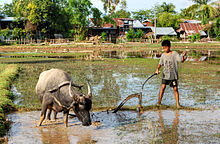

A plough or (US) plow (both pronounced /plaʊ/) is a farm tool for loosening or turning the soil before sowing seed or planting.[1] Ploughs were traditionally drawn by oxen and horses but modern ploughs are drawn by tractors. A plough may have a wooden, iron or steel frame with a blade attached to cut and loosen the soil. It has been fundamental to farming for most of history.[2] The earliest ploughs had no wheels; such a plough was known to the Romans as an aratrum. Celtic peoples first came to use wheeled ploughs in the Roman era.[3]
The prime purpose of ploughing is to turn over the uppermost soil,[4] bringing fresh nutrients to the surface[5] while burying weeds and crop remains to decay. Trenches cut by the plough are called furrows. In modern use, a ploughed field is normally left to dry and then harrowed before planting. Ploughing and cultivating soil evens the content of the upper 12 to 25 centimetres (5 to 10 in) layer of soil, where most plant feeder roots grow.
Ploughs were initially powered by humans, but the use of farm animals is considerably more efficient. The earliest animals worked were oxen. Later, horses and mules were used in many areas. With the Industrial Revolution came the possibility of steam engines to pull ploughs. These in turn were superseded by internal-combustion-powered tractors in the early 20th century. The Petty Plough was a notable invention for ploughing out orchard strips in Australia in the 1930s.
Use of the traditional plough has decreased in some areas threatened by soil damage and erosion. Used instead is shallower ploughing or other less-invasive conservation tillage.
The plough appears in one of the oldest surviving pieces of written literature, from the 3rd millennium BC, where it is personified and debating with another tool, the hoe, over which is better: a Sumerian disputation poem known as the Debate between the hoe and the plough.[6]
- ^ "Plough". Cambridge English Dictionary. Retrieved 16 September 2018.
- ^ "Anglo-Saxon 7th Century plough coulter found in Kent". BBC News. 7 April 2011.
- ^ Collingwood, R. G.; Collingwood, Robin George; Nowell, John; Myres, Linton (1936). Roman Britain and the English Settlements. Biblo & Tannen Publishers. p. 211. ISBN 9780819611604.
- ^ "Plow". Encyclopaedia Britannica. Retrieved 16 September 2018.
- ^ Sahgal, A C; Sahgal, Mukul. Living Sci. 8 Silver Jubilee. India: Ratna Sagar. p. 7. ISBN 9788183325035.
- ^ Jiménez, Enrique (2017). The Babylonian disputation poems: with editions of the series of the Poplar, Palm and vine, the Series of the spider, and the Story of the poor, forlorn wren. Culture and history of the ancient Near East. Leiden ; Boston: Brill. pp. 13–18. ISBN 978-90-04-33625-4.